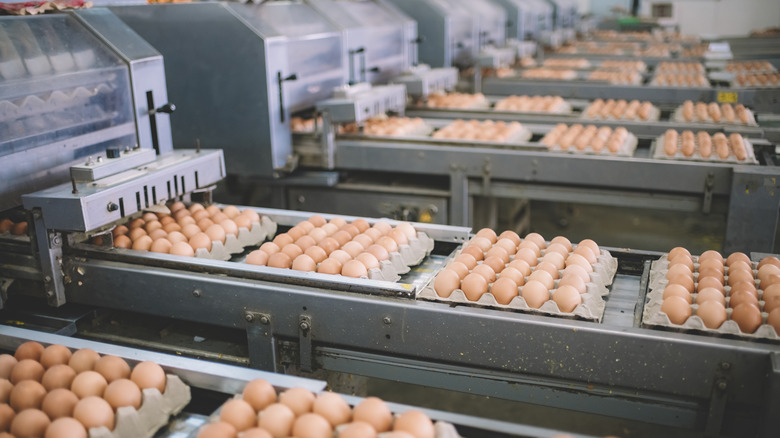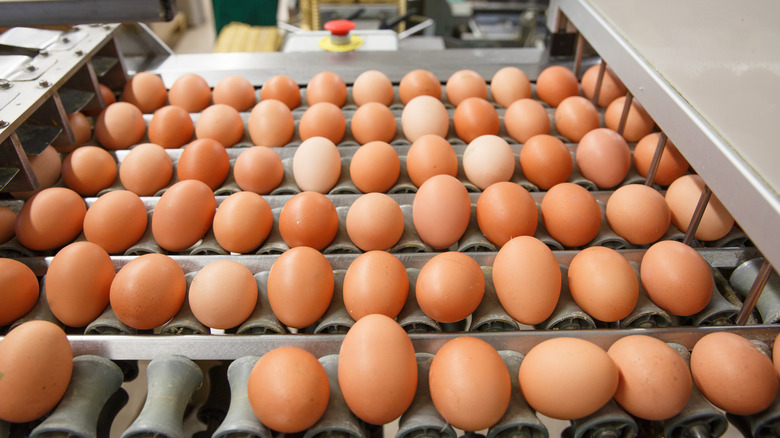The Country That Produces The Most Eggs In The World
In grocery stores in the United States, eggs are typically abundant. Supply chain issues related to COVID-19, the war between Russia and Ukraine, and periodic spikes in avian flu have caused shortages. However, supermarket shelves usually stay well stocked with eggs. But where do all those eggs come from? The United States does indeed produce a significant local supply, but the bulk of global egg production comes from one country.
China produces around 462 billion eggs per year, which is almost double the output of the subsequent four major producers, combined. The egg production in China actually makes up around 40% of global egg production. The eastern provinces of Henan and Shandong are where most of the poultry population — of around 3.3 billion hens – is housed. Once those hens are no longer able to produce eggs efficiently, they are typically processed into protein meal in animal feed. In some parts of Asia, these hens are then sold for their meat.
What other countries are major egg producers?
The United States comes in second place behind China, but it is not a close second at all — the United States puts out around 99 billion eggs annually with the major hubs of production being in Ohio and Iowa. Next comes India with 93 billion, Japan with 32 billion, and Mexico with 27 billion eggs.
The major producers of eggs are among the countries that also consume a lot of eggs. China is again first, followed by India, the United States, Indonesia, and Brazil. Mexico comes in at number six for overall global consumption. When you look at per capita egg consumption, the data shifts a bit. China still holds the first slot with 400 eggs per capita annually but is followed by Mexico at 397, Japan at 339, Indonesia at 329, and the United States at 320.
Interestingly, India's per capita egg consumption is only about 75 per person, per year. That is because India's population is greater than around 1.3 billion people. Religion and cost barriers are other influences on egg consumption. Individuals who identify as Hindu make up close to 80% of the overall population. Though there is quite a bit of variation in diet based on geographical region, socio-economic standing, caste, and personal preferences, many Hindus observe a vegetarian diet that does not allow the consumption of eggs.
Is there a difference in quality depending on where the eggs come from?
Most countries will have their own regulations around food safety and quality, and there are some regional bodies that regulate it as well — like the European Union Common Market Organization rules. In general, egg quality looks at both the outside of the egg like with "shell cleanliness, texture, and shape," and the internal qualities like "the egg white (albumen) cleanliness and viscosity, size of the air cell, yolk shape, and yolk strength" (via The Poultry Site). There are some different standards though. For example, eggs aren't always washed outside of the United States, and the U.S. does not require a salmonella vaccine for egg-laying hens like in the United Kingdom
In the United States, the Department of Agriculture (USDA) grades eggs as AA, A, or B, whether they are locally produced or internationally imported. AA and A eggs are very similar in quality — A-graded eggs are a bit older, so the egg white is less firm. Both these categorizations are available whole and raw in the egg aisle, though A eggs are more common than AA. B-graded eggs have some sort of flaw like a damaged shell, stain, or blood spots. They are still totally safe to eat, so these eggs are processed into powdered, liquid, or frozen forms.



